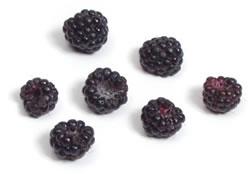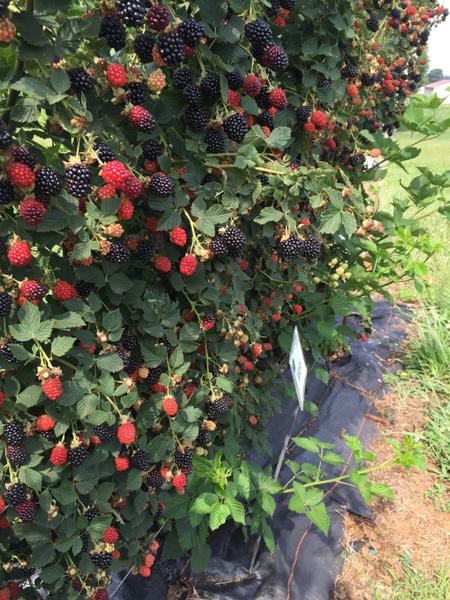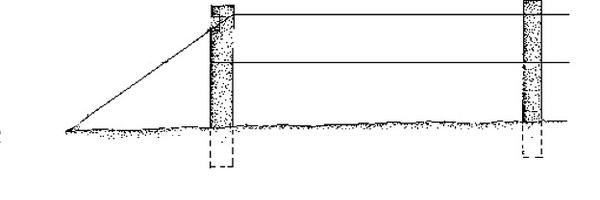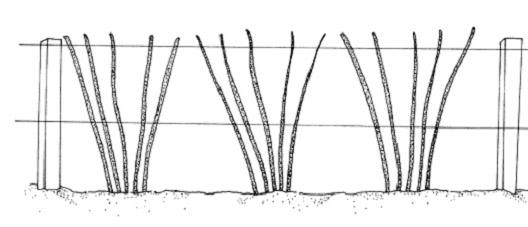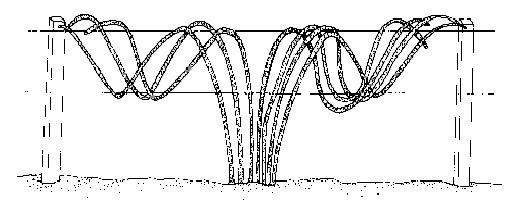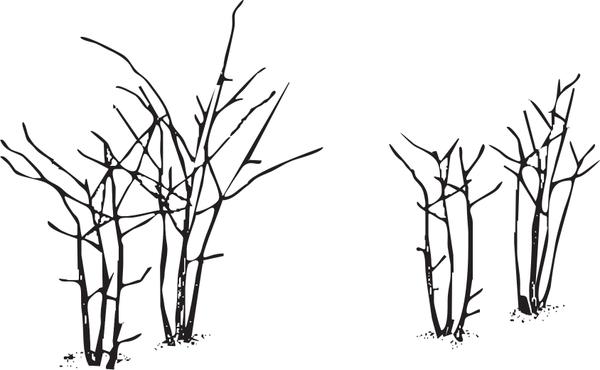Introduction
Small fruits are popular additions to the home garden. Blackberries, in particular, are productive and well suited for homeowners in most regions of North Carolina. Breeding programs have released a number of thornless varieties that are large, taste great, and because they have no thorns, are much easier to harvest than berries found in the wild. In addition, studies have shown that this fruit can help fight cancer, decrease cardiovascular disease, and slow down brain aging. Best of all, one blackberry plant can easily supply up to 10 pounds of delicious berries each year.
How to tell the difference between a black raspberry and a blackberry:
The core (technically the receptacle or torus) of the black raspberry fruit is hollow. The receptacle stays attached to the plant. In a blackberry, the receptacle is harvested with the plant and you eat it.
Types of Blackberries
Blackberries are divided by their growth habit (trailing, semi-trailing, and erect), by the presence or absence of thorns (thorny or thornless), and more recently by floricane- and primocane-fruiting types (also known as everbearing or double cropping). All blackberries benefit from some sort of support such as a trellis or poles to support their canes. If you have room for several plants, select early-, mid-, and late-season varieties to extend your harvest (Table 1). Each of these varieties should perform well in all regions of North Carolina except where temperatures drop below 10°F.
| Variety | Cane Type | Season | Comments |
|---|---|---|---|
| Natchez
|
Erect
|
Early
|
Elongated fruit
Prune heavily |
| Ouachita
|
Erect
|
Mid
|
Medium to large size, stores well, widely adapted
|
| Osage
|
Erect
|
Mid
|
Similar to Ouachita, smaller berries
|
| Sweet-Ark™ Caddo
|
Erect
|
Early
|
Ripens between Natchez and Ouachita
Large, aromatic fruit |
| Sweet-Ark™ Ponca
|
Erect
|
Early
|
Excellent flavor, short internodes
Dark green leaves retain color all season, nice ornamental appearance |
| Von
|
Erect
|
Mid to late
|
Good flavor, low astringency, good post-harvest
|
| Prime-Ark Freedom
|
Erect
|
Double crop potential, early and late. Recommend floricane crop only, due to variable primocane crop.
|
Floricane crop early
Stiff canes, fruit has short shelf life |
| Prime-Ark Traveler
|
Erect
|
Double crop potential, early and late. Recommend floricane crop only, due to variable primocane crop.
|
Medium fruit size, stores well, low acid
|
Site Preparation
Prepare an easy-to-access location for your blackberries a year before planting. Blackberries need full sun and plenty of room to grow. The soil should be a well-drained sandy loam soil with a pH of 5.5 to 6.5. A soil high in organic matter is beneficial under non-irrigated conditions. If the soil is not well drained, establish the plants in a raised bed.
Blackberry Production Checklist
- Choose a good site one year before you plant.
- Prepare the soil before you plant: remove weeds, add organic matter, add fertilizer, make raised beds.
- Choose a variety that is adapted to North Carolina and purchase disease-free plants.
- Plant in spring (western North Carolina) or spring or fall (central and eastern North Carolina)
- Build a trellis (can be done before or within first year of planting).
- Irrigate on a regular basis.
- Allow three to four new canes per plant to grow to the top wire.
- Harvest a baby crop of fruit one year after planting and a full crop two years after planting.
- After fruit is harvested, prune out fruiting canes.
Establishment and Maintenance
Erect and semi-trailing blackberry plants should be planted about 3 to 4 feet apart, while the trailing types need 6 to 8 feet between plants. They can be planted in the early spring several weeks before the last frost. Each plant can produce 10 to 20 pounds of fruit, so four to six plants will easily produce ample berries for a family of four.
Dig a hole that is large enough to allow the roots to spread out evenly. Set bare-rooted plants into the soil about 2 inches below the crown—the point where the stem and roots merge. Fill in the hole and tamp down the soil. Water the newly set plants well, but don’t fertilize until three or four weeks later.
Fertilize after growth starts with a complete fertilizer such as 10-10-10 at 5 pounds per 100 linear feet (or about 3 to 4 ounces around the base of each plant). In established plantings, apply the fertilizer in March well before the plant starts to produce flowers and fruit.
Support the canes with a trellis. Erect and semi-trailing types perform well using a two-wire system with wires at 3 and 5 feet from the ground (Figure 1). As the canes emerge in the spring, evenly distribute them on the wires to form a fan pattern (Figure 2) Once the canes have reached the top wire, remove the tips to encourage branching. Trailing types set further apart require a different system. Start with a similar trellis with wires at 3 and 5 feet, except do not tip the canes. Instead, allow them to grow to the top wire and then weave them back down to the bottom wire and back up to the top wire to fill in the space between plants (Figure 3).
Blackberries require about 1 inch of water each week during the growing season. During fruit development, the plants will need about 2 gallons per plant each day. Mulch placed around the base of the plant reduces the need for water and helps keep weeds under control. Pine straw, wood chips, and seedless grasses are good mulches.
The fruit is ripe and at its peak sweetness when it is a dull black color. Pick fruits that are shiny black if you need to store them in your refrigerator. They won’t be as sweet, but they will last longer. Harvest will continue for three or more weeks, depending on variety.
As soon as all the fruit is harvested, prune out all the old fruiting canes and remove them from the garden, as they no longer produce fruit. Fertilize after harvest, but well before fall, a second time with 5 pounds of 10-10-10 per 100 linear feet of row. Continue to tie, tip, or train the new canes that have not produced fruit to the trellis until growth stops in the fall. During winter, prune laterals on erect types to 12 to 16 inches, and leave only four to eight canes per square yard for fruit production in the following year (Figure 4).
Primocane-fruiting types, also known as everbearing or double cropping, can be grown to produce fruit twice in a season. They will produce fruit in the late summer or fall on the tips of the new canes. If the canes are left for a second year, they will produce fruit in the second season and then die. If you choose to double crop, prune the canes in the first winter as if you were growing a floricane-fruiting type. If you choose to grow only a single crop in the late summer and early fall, prune the canes to the ground each winter. These types of blackberries will double crop best in western North Carolina, as the summer heat in the piedmont and coastal plain will limit flower and fruit development.
Good horticultural practices can prevent insect and disease problems. Timely pruning, removing fruited canes, and maintaining a regular harvest schedule will help minimize common pests. If necessary, apply pesticides labeled for use on edible plants to manage insect and disease problems.
Visit the following resources for further information:
- Commercial-scale production: The Southern Region Small Fruit Consortium
- Other small fruits for the homeowner: NC State Extension Gardening Publications
- Help with insect and disease identification: NC State Blackberry Diagnostic Tool
Acknowledgments
This publication is a substantial revision of Blackberry for the Home Garden by E. Barclay Poling, Extension Horticulture Specialist.
Publication date: March 21, 2024
AG-702-11
N.C. Cooperative Extension prohibits discrimination and harassment regardless of age, color, disability, family and marital status, gender identity, national origin, political beliefs, race, religion, sex (including pregnancy), sexual orientation and veteran status.

